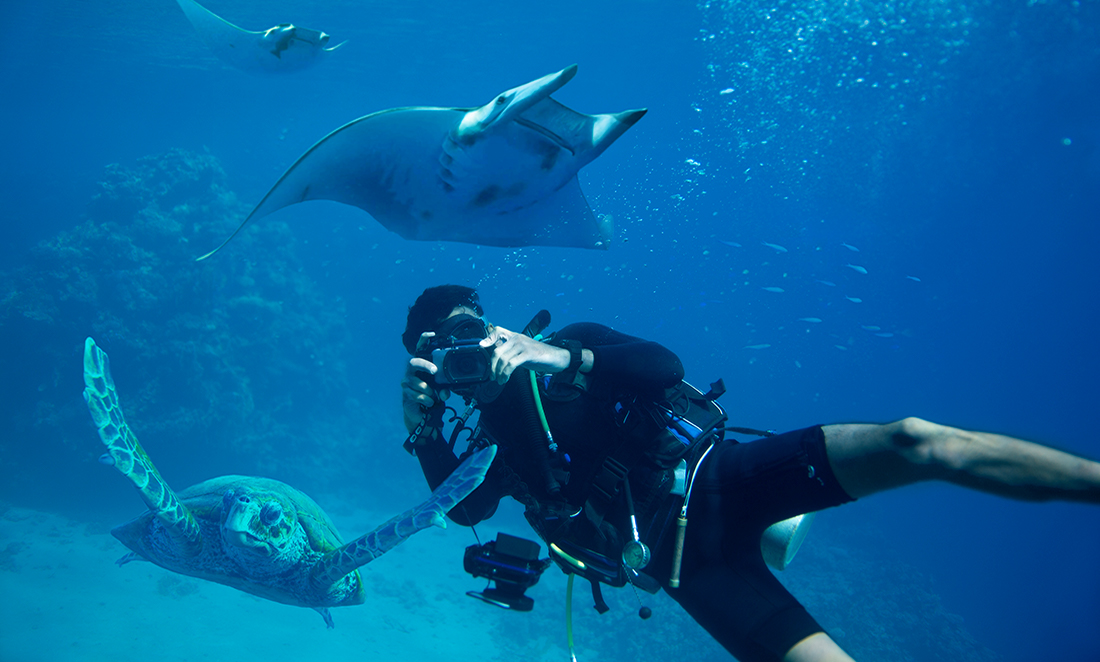There are all sorts of weird things happening in the deep blue. Climate change, ocean acidification, coral bleaching—need we say more? Fine. Plastic pollution. There, are you happy?
Anyway, scientists know that observing where fish and other marine life go can be early indicators of these big changes in marine environments. They’re the sea canaries in a massive watery mine.
Unfortunately, scientists can’t observe everything themselves.
Although scientists can’t be everywhere, the rest of us can give it a red hot crack. Every day, hundreds of Aussies dive, swim and fish in our waters and walk our beaches. Arm them with cameras, and you’ve got your very own civilian science soldiers ready to wage war on data deficiency.
ON THE MAP
Redmap is an online citizen science project that asks members of the community to submit photos of unusual sightings of marine animals and plants that they come across on oceanic adventures.
The location of the unusual sighting is logged in a database. Collectively, these sightings allow scientists to track changes in species distribution and infer conditions about the environment.
Citizen science projects are a great way to collect a lot of data from many locations and over long periods of time. But they’re not perfect. Citizens are just that—citizens, not specialists—so sometimes things can be misidentified.
But a great strength of Redmap is that there is an online network of experienced scientists, experts in identifying marine species, ready to verify the citizens’ photographic submission.
ORIGINAL FINS
Like some of the marine organisms that are sighted, snapped and submitted, Redmap began elsewhere in Australia.
It started in 2009, an initiative of Dr Gretta Pecl and colleagues at the Institute for Marine and Antarctic Studies in Hobart, Tasmania.
Redmap Tasmania was widely recognised as a wonderful initiative. In 2010, it was commended in the Royal Zoological Society of NSW Whitely Awards.
It was such a hit with the community that the project went national and migrated over to WA and has been running here since 2012 after an abnormal marine heatwave created vast disturbances in marine ecosystems off our west coast.
SEA CHANGE
Changing climates and warming waters mean the possible areas that marine life inhabit are changing.
Over the millennia, species have evolved to operate best at certain temperatures. Their food will grow at that temperature, they’ll filter oxygen out of the water best at that temperature and, for most fish, their body temperature will be determined by the temperature of the water in which they live.
This normally means they’re restricted to the locations that exist at those temperatures.
But as warmer waters spread, fish can go wandering.
Not because they have any intention of colonising new territory or invading other patches of sea turf.
Simply because, now, they can. Thanks, climate change!
THE COOL KIDS
A change in water temperature can have severe physiological effects on fish.
As water temperature warms, less oxygen is able to dissolve in the water.
So not only will fish be less efficient at getting oxygen from the water, but there is less oxygen to be getting in the first place.
If they do get enough oxygen to generate energy and use that energy to reproduce, there are further implications of the warming temperature.
For some fish, including one species of sea bass, whether you are a male or a female depends not on your x or y chromosome but the temperature of the water during very early developmental stage.
In one study, the proportion of female fish in the population dropped from around 70% at 13°C to about 26% at 20°C.
And if only 26% of your population is the other part necessary for reproduction, that might spell trouble for the future of those populations.
IN THE RED
Our oceans and marine biodiversity obviously have great intrinsic value. Which other countries can boast the Great Barrier Reef, the Bremer Bay canyon and Ningaloo? But they also have great significance for Aussie recreational activities as well as our economy. The Western rock lobster fishery in WA was valued at $400 million in 2014.
Scientific understanding of these ecosystems is essential in developing management strategies and may allow us to better protect our ocean environments.
Redmap is a great way for the community to help scientists collect data and understand better some of the changes happening in our ocean waters. And Aussies participating in the project get to collect, share, learn and comment on information about their local seas—all while doing the things they love: diving, fishing and swimming.
Despite the great success of Redmap to date, those responsible for running the project are struggling to secure funding to ensure that the project continues into the future. Despite commitments from several partners to contribute funding, without additional support, the future of the project is unsure.







